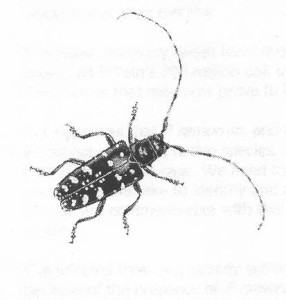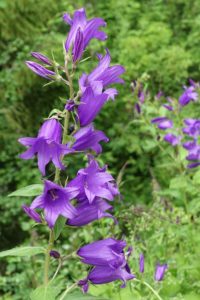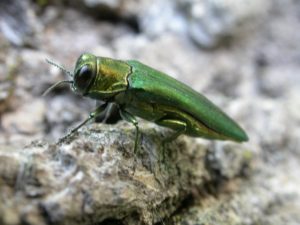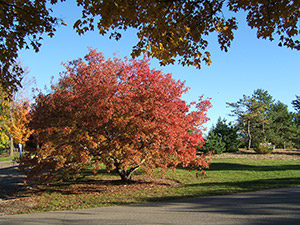Your help is needed to prevent cuts to vitally important programs that protect America’s forests from non-native insects and pathogens.
- USDA APHIS
The USDA Animal and Plant Health Inspection Service (APHIS) is responsible for preventing introductions of new pest that threaten plants – including forest trees — and for carrying out programs to eradicate or contain those that slip through their safeguards. I have blogged often about the unacceptable level of risk that the agency accepts, which enables new pests to be introduced. For examples, search “international trade” or “invasive species policy” on this site.
To see the President’s budget proposal, download the USDA budget justification here; search for “animal and plant”]
APHIS’ most important programs to counter tree-killing pests are funded through the “tree and wood pest” and “specialty crops” accounts. The former account pays for efforts to eradicate the Asian longhorned beetle (ALB), and to slow the spread of the emerald ash borer (EAB). As part of the latter program, it also funds APHIS’ engagement in regulating movement of firewood from quarantined areas.
For several years, the “tree and wood pest” account has been funded at $54 million. This is not sufficient, but we now face worse. The Administration has proposed cutting funding for the “tree and wood pest” account by more than half (from $54 million to $25 million). This level of funding would not even maintain the ALB eradication effort!
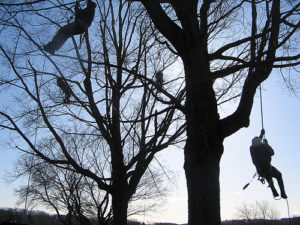 USDA smokejumpers search for ALB
USDA smokejumpers search for ALB
The specialty crop account funds APHIS program to prevent sudden oak death from being spread via the nursery trade. It is slated for a cut of 18.7% (from $172 million to $139 million).
The Administration has proposed cuts to other programs that also would undermine protection for forest trees:
- 24% cut (from $21 million to $16 million) to methods development. This is the program under which APHIS develops new techniques for detecting, monitoring, and controlling pests.
- 5% cut (from $27 million to $22 million) to funding for pest detection. It is counterproductive to reduce programs to detect pests, since early discovery is crucial to successful eradication.
APHIS funds work on the spotted lanternfly (in Pennsylvania) and the polyphagous and Kuroshio shot hole borers (in California) through Section 10007 of the Farm Bill. The Farm Bill sets a funding limit for each year that is not subject to annual appropriations so these programs are not at immediate risk of being defunded. Also, APHIS can request emergency funding from the Commodity Credit Corporation. In February 2018, APHIS obtained $17.5 million in such emergency funding to support enhanced eradication efforts targetting spotted lanternfly in Pennsylvania. APHIS will continue to rely on Section 10007 funds to address this pest in other states to which it has apparently spread (Virginia, possibly Delaware, Maryland, and New Jersey).
Please ask your Congressional Representative and Senators to oppose these proposed cuts!
APHIS receives its annual appropriation through the Agriculture Appropriations bill. This legislation is written by the House and Senate Agriculture Appropriations subcommittees. Members of these subcommittees are listed below. These legislators are especially influential in determining funding for APHIS programs.
House:
- Robert Aderholt, Alabama, Chairman
- Kevin Yoder, Kansas
- Tom Rooney, Florida
- David Valadao, California
- Andy Harris, Maryland
- David Young, Iowa
- Steven Palazzo, Mississippi
- Sanford Bishop, Georgia, Ranking Member
- Rosa DeLauro, Connecticut
- Chellie Pingree, Maine
- Mark Pocan, Wisconsin
Senate:
- John Hoeven, North Dakota
- Thad Cochran, Mississippi
- Mitch McConnell, Kentucky
- Susan Collins, Maine
- Roy Blunt, Missouri
- Jerry Moran, Kansas,
- Marco Rubio, Florida
- Jeff Merkley, Oregon
- Diane Feinstein, California
- Jon Tester, Montana
- Tom Udall, New Mexico
- Patrick Leahy, Vermont
- Tammy Baldwin, Illinois
- USDA Forest Service
The Administration has proposed damaging decreases in both research and management programs that target non-native insects and pathogens.
- Research & Development
The research budget proposal contains numerous figures which don’t appear to add up. I have contacted USFS budget officials to learn how to understand these apparent discrepancies. To read the overall USFS budget, go here.
The budget proposes cutting overall research by 14.8% — from $306,216,000 to $260,800,000. According to the table on p. 30 of the budget justification, invasive species research is allocated $28,558,000. The text says this is 17% of the total Research budget – but my calculation is that it is 10.9%. The discrepancy apparently resulted from a failure to adjust to last-minute changes in funding amounts. The invasive species allocation is described as being a decrease of $3,217,000 from the FY18 figure. Despite these cuts, invasive species are described as one of six “strategic program areas”.
The Forest Service provides a table breaking out funding for work by the research stations on more than a dozen individual pest species or groups of species. The table listing this spending (on pp. 45-46) shows a total of $7,591,000 for FY18 and $6,271,000 for FY 19. The $22 million remaining in the “invasive species” program is apparently spent by staff at headquarters or possibly regional offices. I am trying to find out what this larger category of expenditures includes.
Furthermore, the $6.2 million total includes programs targetting several native species (western bark beetles, southern pine beetle), as well as subterranean termites and invasive plants. If one subtracts expenditures for those species, only $3,091,000 is allocated to non-native tree-killing insects and pathogens in FY18 and $3,252,000 for FY19. This is 1.2% of the overall research budget. Cuts for the individual species range from 19% to 21%.
Since 2010, total funding for research on the ten specified non-native insects and pathogens has fallen by more than 60% — from about $8 million to $3 million. The table listing expenditures on individual species cannot be complete; for example, it does not include efforts to breed pest-resistant elm and beech. Nor does it include recently detected pests, such as spotted lanternfly and polyphagous and Kuroshio shot hole borers – which I hope the Forest Service is studying.
The budget foresees a 42% cut in staff-years from FY18 to FY19 – from 1,469 to 855. USFS Research staffs have been falling for several years (illustrative graph is available in Chapter 6 of Fading Forests III here.) Supportive funds to cover costs of travel, fieldwork, student assistants, and grants to universities have also fallen precipitously, further impeding research efforts.
- State & Private/ Forest Health Management
The Administration’s proposed budget for the USFS proposes a cut of 8.5% in the program that actually combats damaging pests. The cut to funding for pest-management projects on federal lands is 6.5% ($55,123,000 to $51,495,000). The cut to funding for work on state and private lands (the “cooperative lands” account) is 11% ($38,735,000 to $34,376,000). The budget assumes corresponding cuts to staff by 11% (341 staff-years).
The justification notes that, with this budget, the Service will be able to treat fewer acres, so the agency will “focus on the most pressing needs for forest restoration and reducing communities’ risk to wildfire”.
I consider the ostensible focus to be highly misguided. Even the budget justification concedes that pests and pathogens cause billions of dollars of damage each year and that pest-management methods are more effective when treatments are applied regardless of land ownership. Indeed, history shows that pests enter and first establish in urban and suburban areas that receive the imports that transport pests, like wood packaging or nursery stock. If the USFS fails to help counter pests at these introduction sites, it dooms itself to dealing with well-established invaders – at best an enormous and expensive effort, at worst, failure.
As noted earlier, the table on pp. 45-46 lists spending on individual pest species. The total given is $21,356,000 in FY18; the proposal cuts spending to $19,407,000 in FY19. As above, I subtract expenditures for native species (western bark beetles, southern pine beetle), subterranean termites, and invasive plants. The resulting subtotals are $12,874,000 for FY18 and $11,681,000 for FY19. As usual, the gypsy moth receives the bulk of the expenditures — 62% for both years. To meet the lower total mandated for FY19, spending is cut 8 – 9% for each non-native species listed.
In FY10, spending on the 11 named non-native insects and pathogens was $24 million. By FY18, it had fallen by nearly 50% — to $12.8 million. Pest species suffering the largest cuts are the Asian longhorned beetle (zeroed out), hemlock woolly adelgid (52% decrease), oak wilt (27% decrease), sudden oak death (18% decrease), and the combination of goldspotted oak borer, thousand cankers disease, and laurel wilt (15% decrease). The budget justification document does not provide sufficient information to allow me to judge the wisdom of the individual cuts.
It is troubling that the table makes no mention of other invaders – e.g., polyphagous & Kuroshio shot hole borers, spotted lanternfly, velvet longhorned beetle, winter moth (this last is mentioned in the narrative). The first four are relatively new pests with costs that could impose catastrophic damage if they are not countered by adequate programs.
- Urban Forestry and International Programs
The budget proposes to eliminate funding for both urban forestry and international programs. I consider both programs important to invasive species management. The former strengthens forestry programs and public support for them in the very places where new pests are most likely to be introduced! The international program supports cooperation with foresters in foreign countries – the sources for potentially invasive insects and pathogens, as well as locales that can provide possible agents for biological control.
Please ask your Congressional Representative and Senators to oppose these proposed cuts!
The Forest Service receives its annual appropriation through the Interior Appropriations bill. This legislation is written by the House and Senate Interior Appropriations subcommittees. Members of these subcommittees are listed below. Again, please let them know of your concerns.
House:
- Ken Calvert, California, Chairman
- Mike Simpson, Idaho
- Tom Cole, Oklahoma
- David Joyce, Ohio
- Chris Stewart, Utah, Vice Chair
- Mark Amodei, Nevada
- Evan Jenkins, West Virginia
- Betty McCollum, Minnesota, Ranking Member
- Chellie Pingree, Maine
- Derek Kilmer, Washington
- Marcy Kaptur, Ohio
Senate:
- Lisa Murkowski, Alaska
- Thad Cochran, Mississippi
- Lamar Alexander, Tennessee
- Roy Blunt, Missouri
- John Hoeven, North Dakota
- Mitch McConnell, Kentucky
- Steve Daines, Montana
- Shelly Moore Capito, West Virginia
- Diane Feinstein, California
- Patrick Leahy, Vermont
- Jack Reed, Rhode Island
- John Tester, Montana
- Jeff Merkley, Oregon
- Chris Van Hollen, Maryland
Posted by Faith Campbell
We welcome comments that supplement or correct factual information, suggest new approaches, or promote thoughtful consideration. We post comments that disagree with us — but not those we judge to be not civil or inflammatory.
